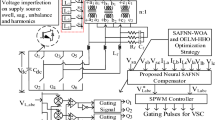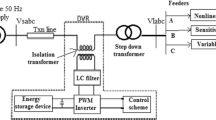Abstract
This article proposes a machine learning-based dynamic voltage restorer (DVR) control strategy for addressing the conventional design procedure of fuzzy logic that needs human expertise to decide membership functions. A randomized evolving Takagi–Sugeno (ReTSK) machine learning approach is proposed for the estimation of fundamental weight components from the polluted grid for enhanced DVR compensating capability. A recurrent probabilistic fuzzy neural network (RPFNN) control is employed for encountering the manual parameters tuning approach of a proportional-integral controller that depends on the optimized coefficients during severe voltage disturbances. The outlined approaches demonstrate robust performance by improving the DC- and AC-link voltage regulation with parametric variations and disturbances. The recommended RPFNN control provides a better response during the transitory state in terms of performance indicators like rise time (0.15 s), settle time (0.08 s), overshoot (3.3%), undershoot (3.3%) and recovery time (0.42 s). Advanced meta-algorithms like Seagull and Rat Swarm Optimization are employed for the self-tuning of the controller’s parameters and compared with competitive algorithms like Moth-Flame Optimization, Spotted Hyena Optimizer and Harris Hawks Optimization. The results of best-fitted forecasting models ReTSK are evaluated by using statistical performance indices (MSE, RMSE, ME, SD and R), while RPFNN are assessed by (MSE, RMSE MAE, MAPE, SI and R). The performance results confirm the validation of the developed control strategies which emphasize their relevance.


















Similar content being viewed by others
References
A. Ghosh, G. Ledwich, Power quality enhancement using custom power devices (Springer International, Del, 2009)
E. Acha, V.G. Agelidis, O. Anaya Lara, T.J.E. Miller, Power electronics control in electrical system (Newnes Power Engineering Series, New York, 2002)
P. Kanjiya, B. Singh, A. Chandra, K. Al-Haddad, SRF theory revisited to control self-supported dynamic voltage restorer (DVR) for unbalanced and nonlinear loads. IEEE Trans. Ind. Appl. 49(5), 2330–2340 (2013)
D. N. Katole, M. B. Daigavane, S. P. Gawande and P. M. Daigavane, Improved single phase instantaneous p-q theory for DVR compensating nonlinear load. In Proc. of the IEEE International Conference on Power Electronics, Drives and Energy Systems (PEDES), 2018.
S. Ahmad, S. Mekhilef and H. Mokhlis, “DQ-axis synchronous reference frame-based P-Q control of grid connected AC microgrid. In Proc. of the IEEE International Conference on Computing, Power and Communication Technologies (GUCON), pp. 842–847, 2020.
K.H. Kwan, P.L. So, and Y.C. Chu (2005), Unified power quality conditioner for improving power quality using MVR with Kalman filters. In Proc. of the International Power Engineering Conference, vol. 2, pp. 980–985, Singapore.
Z. Moravej, A.A. Abdoos, M. Pazoki, Detection and classification of power quality disturbances using wavelet transform and support vector machines. J. Electr. Power Compon. Syst. 38(2), 182–196 (2009)
P. Chittora, A. Singh, M. Singh, Simple and efficient control of DSTATCOM in three phase four wire polluted grid system using MCCF-SOGI based controller. IET Gener. Transm. Distrib. 12(5), 1213–1222 (2017)
S. Biricik, H. Komurcugil, N.D. Tuyen, M. Basu, Protection of sensitive loads using sliding mode controlled three-phase DVR with adaptive notch filter. IEEE Trans. Industr. Electron. 66(7), 5465–5475 (2019)
B. Singh, J. Solanki, An implementation of an adaptive control algorithm for a three-phase shunt active filter. IEEE Trans. Industr. Electron. 56(8), 2811–2820 (2009)
T. Aboulnasr, K. Mayyas, A robust variable step-size LMS type algorithm: Analysis and simulations. IEEE Trans. Signal Process. 45(3), 631–639 (1997)
T.A. Naidu, S.R. Arya, R. Maurya, P. Sanjeevikumar, Variable fractional power-least mean square-based control algorithm with optimized PI gains for the operation of dynamic voltage restorer. IET Power Electr. 14, 821–833 (2021)
A. Ranjan, S. Kewat, B. Singh, Reweighted L1 norm penalized LMS fourth algorithm of solar grid interfaced system for alleviating power quality problems. IEEE Trans. Ind. Appl. 56(5), 5352–5362 (2020)
H. Elmasry, H. Z. Azazi, E. El-kholy, and Shorky A. Mahmoud A proposed transformer-less dynamic voltage restorer to voltage sag/swell mitigation. In Proc. of the IEEE Conference on Power Electronics and Renewable Energy (CPERE), pp. 530–534 (2019)
K.W. Kow, Y.W. Wong, R.K. Rajkumar, R.K. Rajkumar, A review on performance of artificial intelligence and conventional method in mitigating PV grid-tied related power quality events. J. Renew. Sustain. Energy Rev. 56, 334–346 (2016)
Q. Huang, Y. Li, H. Wu, D. Kong, and J. Ma, Three-phase dynamic voltage restorer based on self-tuning fuzzy proportional resonance control, in Proc. of China International Conference on Electricity Distribution (CICED), pp. 1082–1086, (2022)
J. Joh, Y.H. Chen, R. Langari, On the stability issues of linear Takagi-Sugeno fuzzy models. IEEE Trans. Fuzzy Syst. 6(3), 402–410 (1998)
X. Chen, Y. Li, Y. Zhang, X. Ye, X. Xiong, F. Zhang, A novel hybrid model based on an improved seagull optimization algorithm for short-term wind speed forecasting. J. Process 9, 387 (2021)
G. Dhiman, V. Kumar, Seagull optimization algorithm: Theory and its applications for large-scale industrial engineering problems. J Knowl.-Based Syst. 165, 169–196 (2019)
N. Patel, A. Kumar, N. Gupta, Electronically coupled photovoltaic system with grey wolf optimizer enabled DC-link voltage control loop. J. Electr. Energy Syst. 30(12), 1–21 (2020)
N. Kassarwani, J. Ohri, A. Singh, Performance analysis of dynamic voltage restorer using improved PSO technique. Int. J. Electr. 106, 1–25 (2018)
C. Benachaiba, B. Mazari, M.N. Tandjaoui, and A.M. Haidar, Power quality enhancement using DVR based on ant colony controller, in Proc. of International Scientific Conference on Power and Electrical Engineering of Riga Technical University (RTUCON), pp.1–4 (2016)
C.K. Sundarabalan, K. Selvi, Compensation of voltage disturbances using PEMFC supported dynamic voltage restorer. Int. J. Electr. Power Energy Syst. 71, 77–92 (2015)
S. Karmakar, T. K. Bera, and A. K. Bohre, Novel PI controller and ANN controllers- Based passive cell balancing for battery management system. IEEE Transactions of Industrial Applications, (2023)
S. Karmakar, T. K. Bera, and A. K. Bohre, Review on cell balancing technologies of battery management systems in electric vehicles, in Proc. of IEEE IAS Global Conference on Renewable Energy and Hydrogen Technologies (GlobConHT), pp. 1–5 (2023)
S. Karmakar, T. K. Bera, and A. K. Bohre, A novel proportional integral controller based passive cell balancing for battery management system. In Proc. of IEEE Global Conference on Computing, Power and Communication Technologies (GlobConPT), pp. 1–5 (2022)
S. Karmakar and S. N. Mahato, Artificial neural network- based electronic load controller for self-excited induction generator. pp. 1–5, (No. 2261), (2019)
S. Karmakar, Artificial neural network-built electronic load controller for three-phase self-excited induction generator feeding single-phase load. In Proc. of Michael Faraday IET International Summit, pp. 185–1190, (2021)
Y. Chu, J. Fei, S. Hou, ‘Adaptive global sliding-mode control for dynamic systems using double hidden layer recurrent neural network structure.’ IEEE Trans. Neural Netw. Learn. Syst. 31(4), 1297–1309 (2020)
K.H. Tan, J.H. Chen, Y.D. Lee, Intelligent controlled dynamic voltage restorer for improving transient voltage quality. IEEE Access 11, 74686–74701 (2023)
G. Dhiman, M. Garg, A. Nagar, V. Kumar, M. Dehghani, A novel algorithm for global optimization: Rat swarm optimizer. J. Ambient. Intell. Humaniz. Comput. 12, 8457–8482 (2021)
Funding
No funding for this work.
Author information
Authors and Affiliations
Corresponding author
Ethics declarations
Competing Interest
The authors reveal no competing interests.
Additional information
Publisher's Note
Springer Nature remains neutral with regard to jurisdictional claims in published maps and institutional affiliations.
Appendices
Appendix A
Simulation System Parameters
Supply mains: 410 V(L-L), 50 Hz; grid impedance (Rs and Ls) = 0.01 Ω, 2mH, respectively; load current (iL) = 21A; filter: Rf = 6 Ω, Cf = 10 μF; interface inductor Lf = 1.3mH; dc bus capacitor Cdc = 3300 μF; dc bus voltage Vdc = 300 V; AC bus voltage (Vt) = 335 V; load:18kVA (0.8 p.f. lag.), sample time (ts) = 20 µs.
ReTSK-SOA Data: Parameters considered for simulation are total epochs (1000), type/number of MFs (Gaussian), and learning method (SOA). The parameters of the proposed model after training with SOA are given as the number of neurodes = 126, linear and nonlinear variables are 60 and 90, respectively, the total variables = 150, training data pairs = 63,751 and fuzzy rules = 15. The K-FCM is utilized for data clustering in this method as it requires less parameters to find the optimal global solution for various inputs.
Appendix B
Experimental Parameters
Polluted supply voltage: 110 VL-L, 50 Hz; 0.353 kVA load; 2 A load current (iL); DVR interface two winding transformer: 4 kVA, 125/125 V; dc bus voltage (Vdc) = 60 V; capacitor at dc bus (Cdc) = 4700 μF; and interfacing inductor (Lf) = 0.5mH; switching ripple filtering elements: Rf = 10 Ω and Cf = 120μF.
Rights and permissions
Springer Nature or its licensor (e.g. a society or other partner) holds exclusive rights to this article under a publishing agreement with the author(s) or other rightsholder(s); author self-archiving of the accepted manuscript version of this article is solely governed by the terms of such publishing agreement and applicable law.
About this article
Cite this article
Arya, S.R., Mistry, K.D. & Kumar, P. DVR Using Randomized Self-Structuring Fuzzy and Recurrent Probabilistic Fuzzy Neural-Based Controller. J. Inst. Eng. India Ser. B (2024). https://doi.org/10.1007/s40031-023-00973-1
Received:
Accepted:
Published:
DOI: https://doi.org/10.1007/s40031-023-00973-1




